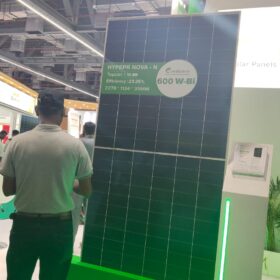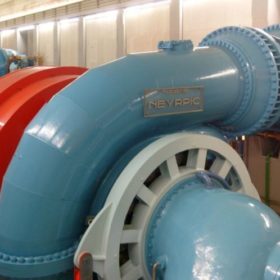With the government’s ambitious target to achieve 500 GW of non-fossil fuel-based energy by 2030, optimizing solar investments becomes crucial for maximizing returns and sustainability in this rapidly expanding market.
India has set a target to reduce the carbon intensity of the nation’s economy by less than 45% by the end of the decade, achieve 50 percent cumulative electric power installed by 2030 from renewables, and achieve net-zero carbon emissions by 2070. The nation aims for 500 GW of renewable energy installed capacity by 2030. It aims to produce 5 million tonnes of green hydrogen by 2030. This will be supported by 125 GW of renewable energy capacity. Further, 50 solar parks with an aggregate capacity of 37.49 GW have been approved in India.
Wind energy has an offshore target of 30 GW by 2030, with potential sites identified.
The Union Cabinet chaired by Prime Minister Narendra Modi has given its approval to introduce the Production-Linked Incentive (PLI) Scheme in High Efficiency Solar PV Modules for enhancing India’s manufacturing capabilities and enhancing exports.
Investments in renewable energy in India reached a record $14.5 billion in the financial year (FY2021-22), 125% up compared to FY2020-21 and 72% over pre-pandemic FY2019-20. The surge in investment comes on the back of the revival of electricity demand after the COVID-19 slump and commitments by financial institutions to exit fossil fuels.
Solar growth in India
India has experienced remarkable growth in solar power capacity, making it one of the leading countries in solar energy. The installed solar energy capacity has increased by 30 times in the last 9 years and stands at 81.81 GW as of Mar 2024. India’s solar energy potential is estimated to be 748 GWp as estimated by National Institute of Solar Energy (NISE).
For India’s solar industry in 2023, here are the latest numbers related to the utility and residential segments:
- Utility Segment: India’s utility-scale solar capacity is substantial, with about 55 GW installed as of 2023, indicating significant growth in this sector. Making a case for a much faster scale up to meet this incremental demand growth, this demand growth will overshadow the commitments made by India, which could be met even in a business-as-usual scenario.
- Residential Segment: The rooftop solar installations in the residential sector have also seen significant uptake. As of the end of 2023, the cumulative rooftop solar installations reached approximately 10.5 GW, with the residential segment driving much of the new additions. In 2023 alone, India installed 1.7 GW of rooftop solar capacity, with the residential segment accounting for over half of this capacity.
This represents a significant increase from just 2.6 GW in 2014, showcasing an impressive growth trajectory over the past decade. The expansion is part of India’s broader commitment to renewable energy, with a national target to reach 500 GW of renewable capacity by 2030.
Data-driven assets
Utilizing sophisticated data analytics software, property managers can continuously monitor several key performance indicators (KPIs) critical to the efficiency and profitability of solar installations. These KPIs include:
- Energy Output: Real-time tracking of the amount of electricity generated.
- Plant Availability: Monitoring the operational readiness of the solar plant.
- Downtime: Identifying and analyzing system downtimes to minimize their impact.
According to recent industry insights, leveraging advanced monitoring systems equipped with predictive analytics and machine learning can enhance solar power plant performance by up to 15%. This improvement is driven by the system’s ability to anticipate maintenance needs and optimize energy output based on comprehensive data analysis.
Various analytical techniques are employed in the renewable energy industry, with the primary objective of detecting faulty equipment and irregular energy production, optimizing configurations to maximize energy output, and assessing solar energy potential for specific regions.
Data analytics in solar energy poses significant benefits for both utility companies and their customers. By leveraging data analytics software and energy dashboards, energy managers can effectively monitor and minimize grid downtime, accurately predict fluctuations in market demand, optimize asset allocation, and track progress toward environmental goals in real-time. Simultaneously, energy consumers can utilize energy data analytics to pinpoint opportunities for cost savings, align their usage with strategic objectives, and engage with site management to address energy consumption challenges.
Economic impact
Property management directly impacts the financial return on investment in solar energy. Through regular performance monitoring and preventive maintenance, solar asset management can increase energy production by approximately 5-10%.
The financial return on investment from a solar project is directly related to the performance of the solar asset. Solar panels degrade over time and lose their efficiency. To maximize ROI, it is important to monitor and manage the performance of solar assets throughout their lifetime. It includes regularly cleaning and maintaining the panels, monitoring output, and troubleshooting any issues that may arise. This increase directly translates into higher revenues for investors, as the additional power generated can either be sold back to the grid at prevailing tariff rates or used to offset higher-cost energy consumption.
Risk mitigation strategies
Solar asset management also plays an important role in reducing the risks associated with solar installations. By conducting a thorough technical inspection, property managers can identify potential hazards such as equipment defects, breakdowns, and malfunctions. Implementing proactive maintenance programs and adopting predictive analytics can quickly address these risks while protecting investment returns.
Compliance and regulatory requirements
In an evolving regulatory environment for renewable energy integration, compliance with regulatory requirements is important for solar owners. Property managers must ensure compliance with relevant laws, standards, and contractual obligations. This includes complying with grid regulations, safety standards, and performance commitments set out in power purchase agreements (PPAs). Failure to comply could result in financial penalties and reputational damage.
Technological innovations
Technological advancements provide opportunities to improve solar asset management practices. Technologies such as artificial intelligence (AI), the Internet of Things (IoT), and blockchain are transforming asset tracking, predictive maintenance, and energy trading, according to industry figures.
In India’s quest for a sustainable energy future, solar asset management emerges as a key to optimizing investments, ensuring reliability and maximizing productivity.
The views and opinions expressed in this article are the author’s own, and do not necessarily reflect those held by pv magazine.
This content is protected by copyright and may not be reused. If you want to cooperate with us and would like to reuse some of our content, please contact: editors@pv-magazine.com.








It appears, the writer haa not taken into account Technology innovations happening in the development of solar panels where the power production from the solar cells is estimated to increase by several folds.
We are doing well known brand in solar ev biofuels gas based power and contract consultant having office in delhi at mayur vihar ph3 or delhi office Indian investors can bring changes in this venture capital investors summit’s and ntpc building epc contractors pmc contract consultants renewable power project doing pmc and contracts consultants job in bhuj adani solar power project doing mms erection works ka kam hai and for a delhi company studio next safderjung enclave design engieering group is interested to back condition company wants meeting time and place in delhi our office mayur vihar ph3 or delhi office SPMISHRA and sunita mishra prop ship enterprise owned by sunita mishra prop ship enterprise madhu india international laision and contract consultant having interest in solar pmc contract consultants renewable energy park working as pmc and contracts consultants job delhi office. India pmc works in india contact us for the same please convey to associate with your company intersted to bid directly if you want we have few solar epc mode value upto 400cr tenders thro our costing estimation survey bidding soil testing drawing and designer engineering consultants based in delhi pmc and contract consultants for any epc contractors pmc tendering costing designing and architectural engineering consultants based in delhi and
We are designing and architectural engineering consultants based in delhi and pmc works ka kam hai app ka office me jab kam hai to batana solar ev biofuels gas based power and contract consultant having office in delhi at mayur vihar ph3 or investments in solar power project doing pmc and contracts consultants job delhi adani solar power project doing pmc contract consultants and ntpc site bhuj gujrat state for a delhi company intersted to bid directly if you want i can get you associated engineering consultants based in delhi and pmc works ka kam hai contact us for the same please convey to associate with your company intersted to bid directly if you want tenders avilable for bidding back to back condition from usa technolgy in Eneegy sector solar power investment is being done by govt of india and uttarpradesh govt official during meeting with you can contact us for the same please convey to associate with us any professional support for costing designing and architectural engineering consultants based in delhi
solar manufacturing work.